This year, I’ve been doing a pretty good job at reading a lot of middle grade novels, but I have not really been keeping up with the new books in any other category, not even picture books. There are a few reasons for that; the main one is that I’m now a stay-at-home mom to a three-month-old baby instead of a librarian. But over the past week or so, I have gotten my hands on several recently-published picture books and a couple readers. So here are my opinions of the ones I’ve enjoyed, plus a couple that I read a month or two ago. Excuse any awkward phrasing or repetitive word choice; most of this was written very quickly with a baby in my lap and I don’t have time to edit and rewrite it properly.
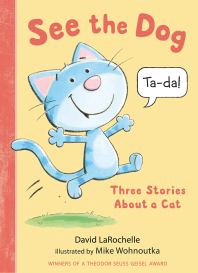 See the Dog: Three Stories About a Cat by David LaRochelle, illustrated by Mike Wohnoutka
See the Dog: Three Stories About a Cat by David LaRochelle, illustrated by Mike Wohnoutka
This early reader is a sequel to the 2020 book See the Cat: Three Stories About a Dog, which won the Theodor Seuss Geisel award, and very rightly so in my opinion. I’ve linked the blog post in which I wrote about that book and explained why I liked it so much. A lot of what I wrote then applies to this newer book as well. It uses a controlled vocabulary well suited to a child who is just starting to read full sentences, but it adds humor by introducing a disconnect between the text and the picture. Although the text on the left side of each double-page spread talks about a dog, using stereotypical early-reader sentences like “see the dog” and “see the dog dig a hole”, the illustrations on the right side show a cat. Word bubbles give additional explanation; the cat explains that the dog is sick and the cat is filling in. For readers who are not ready to read the entire book alone, I would suggest that a parent/ caregiver/ educator read the text in the cat’s word bubbles. Even so, this book is slightly more advanced than See the Cat, so I would recommend starting with that book and then moving on to this one next.
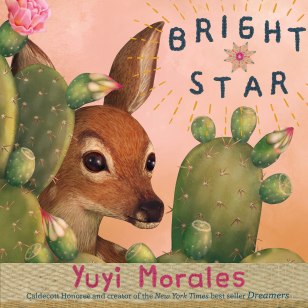 Bright Star by Yuyi Morales
Bright Star by Yuyi Morales
On the surface, this is a simple picture book narrated by a mother deer telling her fawn how special and loved it is. But it also mentions themes of safety and danger, of feeling hurt and expressing that hurt. Set in the desert borderlands between the United States and Mexico, this book is full of beautiful illustrations showing the wildlife, plants, and climate of the region. For many young readers, this book will have educational value as a depiction of that geographical area. The presence of human characters in the final couple illustrations imply that this book is about more than animals, though. A lengthy author’s note at the end of the book specifies some of the social and political issues that she is addressing by implication in this picture book. Those messages are not at all explicit in the body of the book, so I feel that they are only incidental in discussing this book’s literary value, but the beautifully realistic illustrations of wildlife and the feel-good message about the value of the individual are enough to give this book plenty of merit. I would recommend it as a storytime book or a story to read at home with preschool-aged kids.
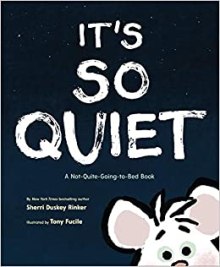 It’s So Quiet: A Not-Quite-Going-To-Bed Book by Sherri Duskey Rinker, illustrated by Tony Fucile
It’s So Quiet: A Not-Quite-Going-To-Bed Book by Sherri Duskey Rinker, illustrated by Tony Fucile
A young mouse claims that it’s too quiet to go to bed, but actually, the mouse family’s farm home is surrounded by loud noises, including a bullfrog’s croak, crickets chirping, granddad snoring on the porch, an owl, and a coyote’s distant howl. The text consists largely of onomatopeias and sound effects, with the entire list being repeated three times over the course of the book. The digitally-created illustrations feature simple shapes and high color contrast because they contain a lot of black and white. Although the publishers and most reviews recommend this for a preschool-aged audience, I would argue that the subject matter, illustrative style, and simple plot are age appropriate for toddlers and even babies. My three-month-old daughter gives it her stamp of approval!
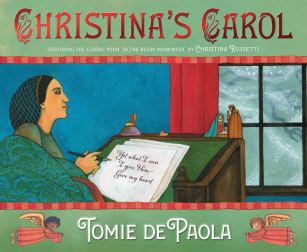 Christina’s Carol: Featuring the Classic Christmas Carol “In the Bleak Midwinter” by Christina Rossetti, illustrated by Tomie DePaola
Christina’s Carol: Featuring the Classic Christmas Carol “In the Bleak Midwinter” by Christina Rossetti, illustrated by Tomie DePaola
Interestingly enough, both of this book’s creators are deceased. The text is by English poet Christina Rossetti, born in 1830. The poem was published under the title “A Christmas Carol” in 1872 and set to music by Gustav Holst for The English Hymnal published in 1906. Rossetti had died in 1894. Popular children’s author/illustrator Tomie DePaola had started illustrating a picture book version of this carol before his death in 2020. Although the project was unfinished, DePaola’s previous work includes multiple depictions of the Nativity. This backstory explains why the completed book includes some variation in artistic style. Fans of DePaola will like this posthumously published book just as much as his previous works, and any library would do well to add this to its children’s holiday or religion section. Also recommended as a Christmas gift.
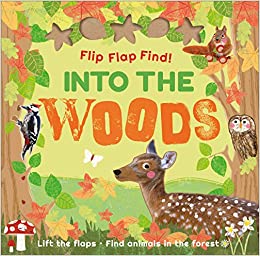 Flip Flap Find: Into the Woods by Dawn Sirett
Flip Flap Find: Into the Woods by Dawn Sirett
This isn’t a book that I checked out and read once or twice just for the sake of reviewing; this is a book that I got for my baby and have read to her at least thirty times already. It seems to be one of her favorites. (Not in the top five, but definitely in her top ten so far) This lift-the-flap board book depicts a variety of forest animals at different times of year, each page featuring a different creature. The text introduces a noise, such as rustling, buzzing, or hooting, and prompts the reader to guess who’s making that noise. The answer, of course, is revealed by lifting the flap. The board book format and bright colors make it suitable for even the very youngest readers, while the educational content and detailed illustrations give the book value and appeal for children up through about four or five years old.
 The Ramble Shamble Children by Christina Soontornvat, illustrated by Lauren Castillo
The Ramble Shamble Children by Christina Soontornvat, illustrated by Lauren Castillo
A family of five children live together in a “ramble shamble” house where there is always work to do tending the garden, caring for the chickens, and playing in the mud. (That’s baby Jory’s job) But after the children find a book in the attic depicting what a “proper house” looks like, they decide to make their own home more proper. They set to work switching out their henhouse for a Victorian dollhouse, replacing their carrots with roses, and making their own diamond chandelier. And they also rake over the mud, because mud isn’t proper. But when Jory goes missing, the older four kids come to the realization that they don’t need their house to be “proper”. With its message about loving your home and its self-reliant protagonists, this story has a timeless quality that is enhanced by the illustrative style featuring textured pastel shapes and bold brown outlines. According to a note on the title page, this distinctive effect was created by digitally combining ink and monoprint techniques. Recommended for readers in early elementary school.
 The Midnight Fair by Gideon Sterer, illustrated by Mariachiara Di Giorgio
The Midnight Fair by Gideon Sterer, illustrated by Mariachiara Di Giorgio
In this wordless picture book, a fair closes for the night only to be visited by a large group of curious forest animals. They help themselves to concessions, play the various carnival games, ride the merry-go-round and other rides, and clean up after themselves before a fair employee arrives to open up in the morning. The only evidence they leave behind is the assortment of leaves and berries they used in lieu of cash in the ticket booth. The book concludes with a sweet scene in which the fox releases the goldfish he received as a prize into the lake. For many readers, especially adults, this nocturnal book will evoke memories of Good Night, Gorilla, but the illustrative style is more realistic and detailed, with the result that this book is better suited for a slightly older target audience. The color palette focuses on contrast between light and dark; there are a lot of blues and grays for everything outside the fair and a lot of bright yellow for the fair lights, sometimes with the animals in silhouette. Thanks to the combination of watercolor, gouache, and pencil, the pictures have a soft and almost ethereal effect but consist of sharply defined lines and shapes. This is a beautiful and memorable picture book that I would highly recommend
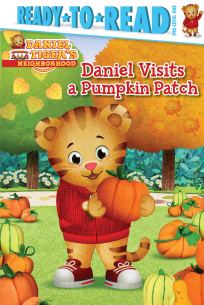 Daniel Visits a Pumpkin Patch by Maggie Testa, illustrated by Jason Fruchter
Daniel Visits a Pumpkin Patch by Maggie Testa, illustrated by Jason Fruchter
The Daniel Tiger’s Neighborhood book series is based on the popular PBS show, which is in turn a spin-off of the Mister Rogers show. Although I am obviously aware of the popularity of Mister Rogers (especially over the last couple years) and the Daniel Tiger franchise, I haven’t paid much attention to the Daniel Tiger books. I only grabbed this one at the library because I’ve read very few early readers from this year and need to read several more in order to put together my Best of the Year list in a couple months. But even though this isn’t a book that was already on my radar, I thought it was a good one. Even readers who aren’t familiar with the characters will enjoy the autumnal subject matter and appreciate the somewhat interactive storyline which invites readers to weigh in on Daniel’s decision about which pumpkin he should pick. Although this book has some long sentences and lots of multi-syllable words, the simple plot and repetition make it well-suited for children who are just starting to move beyond monosyllables and who still need a little help with reading comprehension. Recommended mostly for kindergarteners.
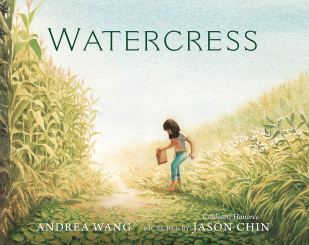 Watercress by Andrea Wang, illustrated by Jason Chin
Watercress by Andrea Wang, illustrated by Jason Chin
A family stops during a road trip to collect watercress that they spot growing in a ditch by the side of the road. The story is told from the first person perspective of the younger sister, who finds the situation embarrassing. When the family gets home and has watercress for dinner, she refuses to eat any. She knows that watercress brings back memories of China for her parents, but what she doesn’t realize is that her uncle starved to death as a child. Although there’s not a lot of text, the sad backstory and poignant message make this picture book more suited for an elementary school age audience than for preschoolers. Readers don’t necessarily need background knowledge about China, but they do need to understand that China is a different country far away and they need to be able to conceptualize the fact that the protagonist’s mother was once a young girl herself. Chin’s soft yet realistic watercolor artwork will appeal to adults as much as to children. Recommended both for educational contexts and for independent, recreational reading.
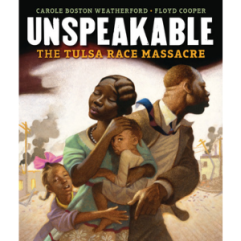 Unspeakable: The Tulsa Race Massacre by Carole Boston Weatherford, illustrated by Floyd Cooper
Unspeakable: The Tulsa Race Massacre by Carole Boston Weatherford, illustrated by Floyd Cooper
This nonfiction picture book uses succinct text and evocative oil-painted illustrations to tell the story of the Tulsa race massacre of 1921. This particular account puts a lot of emphasis on the fact that, despite the segregation and racism of the time and place, the Greenwood District in Tulsa, Oklahoma, was a thriving African American community with some of the most successful Black-owned businesses in the country. But all of that changed after a Black teenager was accused of assaulting a young white woman in an elevator. (Neither of these figures are named in the body of this book, but their names are given in the author’s note at the end) Although the charge was quickly dropped and the accused man released, the seemingly minor incident led to widespread violence in which a white mob destroyed the Greenwood District. No one knows the exact number of casualties. The main thing I’d like to point out about this book is how impressive it is for there to be such a short, child-accessible book about a complex social issue and violence. I personally would recommend this book for elementary-school age kids, although it contains quite a few words that will be new vocabulary for younger readers, including “residents”, “segregation”, and “establishments”. For the record, Unspeakable has several starred reviews and is on the longlist for the National Book Award for young people’s literature. (It did not make the shortlist, but picture books very rarely make the list in the first place) I expect to see it win something in the Youth Media Awards this winter.
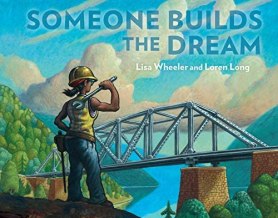 Someone Builds the Dream by Lisa Wheeler, illustrated by Loren Long
Someone Builds the Dream by Lisa Wheeler, illustrated by Loren Long
In this beautiful book full of detailed illustrations, the rhyming text describes a variety of jobs that are necessary to build a “dream”, whether that dream is a house, bridge, decorative fountain, wind power plant, dinosaur roller coaster, or picture book. Each of these sections begins by acknowledging the work of the architect, engineer, or artist whose specialized knowledge and creativity was necessary to begin the project, but then continues to extol the workers who actually physically built the final product. The subject matter will appeal to the same young readers who love books like Goodnight, Goodnight, Construction Site and other popular construction-themed picture books, but this title has an added element of literary and educational value in its description of different jobs and urges readers to appreciate them all. Pair this book with Fix That Clock by Kurt Cyrus (2019) for a construction-themed storytime that focuses on human workers rather than anthropomorphic vehicles, or consider it for a storytime about jobs or Labor Day. Although the text is brief enough and the illustrations colorful enough to hold the interest of a preschooler, this book is perhaps better suited for young readers in the 5- to 8- year old age range and will appeal to plenty of grownups too.
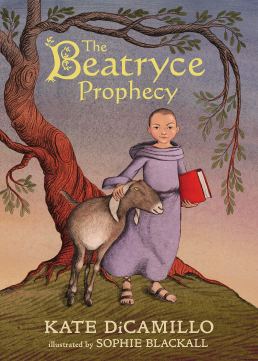 The Beatryce Prophecy
The Beatryce Prophecy